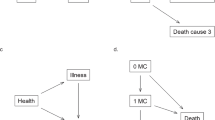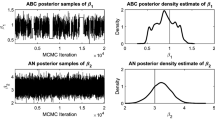Abstract
Doubly truncated survival data arise when event times are observed only if they occur within subject specific intervals of times. Existing iterative estimation procedures for doubly truncated data are computationally intensive (Turnbull 38:290–295, 1976; Efron and Petrosian 94:824–825, 1999; Shen 62:835–853, 2010a). These procedures assume that the event time is independent of the truncation times, in the sample space that conforms to their requisite ordering. This type of independence is referred to as quasi-independence. In this paper we identify and consider two special cases of quasi-independence: complete quasi-independence and complete truncation dependence. For the case of complete quasi-independence, we derive the nonparametric maximum likelihood estimator in closed-form. For the case of complete truncation dependence, we derive a closed-form nonparametric estimator that requires some external information, and a semi-parametric maximum likelihood estimator that achieves improved efficiency relative to the standard nonparametric maximum likelihood estimator, in the absence of external information. We demonstrate the consistency and potentially improved efficiency of the estimators in simulation studies, and illustrate their use in application to studies of AIDS incubation and Parkinson’s disease age of onset.


Similar content being viewed by others
References
Bilker WB, Wang MC (1996) A semiparametric extension of the Mann-Whitney test for randomly truncated data. Biometrics 50:10–20
Efron B, Petrosian V (1999) Nonparametric methods for doubly truncated data. J Am Stat Assoc 94(447):824–825
Koziol J, Byar D (1975) Percentage points of the asymptotic distributions of one and two sample K-S statistics for truncated or censored data. Technometrics 17(4):507–510
Lagakos SW, Barraj LM, DeGruttola V, Hu FB (1988) Nonparametric analysis of truncated survival data, with application to AIDS. Biometrika 75(3):515
Lindsey J, Ryan L (1998) Methods for interval-censored data. Stat Med 17(2):219–238
Mandel M (2007) Censoring and truncation-highlighting the differences. Am Stat 61(4):321–324
Mandel M, Betensky RA (2007) Simultaneous confidence intervals based on the percentile bootstrap approach. Comput Stat Data Anal 52(4):2158–2165
Martin EC, Betensky RA (2005) Testing quasi-independence of failure and truncation times via conditional Kendall’s tau. J Am Stat Assoc 100(470):484–492
Moreira C, de Uña-Álvarez J (2010a) Bootstrapping the NPMLE for doubly truncated data. J Nonparametr Stat 22(5):567–583
Moreira C, de Uña-Álvarez J (2010b) A semiparametric estimator of survival for doubly truncated data. Stat Med 29:3147–3159
Moreira C, de Uña-Álvarez J, Van Keilegom I (2012) Goodness-of-fit tests for a semiparametric model under random double truncation. Unpublished manuscript
Randles R, Wolfe D (1979) Introduction to the theory of nonparametric statistics. Wiley, New York
Rosenberg P, JJ G, RJ B (1994) Effect of age at seroconversion on the natural AIDS incubation distribution. Multicenter Hemophilia Cohort Study and the International Registry of Seroconverters. AIDS 8(6):803–810
Shen P (2010a) Nonparametric analysis of doubly truncated data. Ann Inst Stat Math 62:835–853
Shen P (2010b) Semiparametric analysis of doubly truncated data. Commun Stat 39(17):3178–3190
The NINDS NET-PD Investigators (2006) A randomized, double-blind, futility clinical trial of creatine and minocycline in early Parkinson disease. Neurology 66(5):664–671
Tsai WY (1990) Testing the assumption of independence of truncation time and failure time. Biometrika 77(1):169
Turnbull BW (1976) The empirical distribution function with arbitrarily grouped, censored and truncated data. J R Stat Soc Ser B (Methodol) 38(3):290–295
van der Laan MJ (1996) Nonparametric estimation of the bivariate survival function with truncated data. J Multivar Anal 58:107–131
Vardi Y (1985) Empirical distributions in selection bias models. Ann Stat 13(1):178–203
Wang MC (1989) A semiparametric model for randomly truncated data. J Am Stat Assoc 84(407):742–748
Author information
Authors and Affiliations
Corresponding author
Electronic supplementary material
Below is the link to the electronic supplementary material.
Rights and permissions
About this article
Cite this article
Austin, M.D., Simon, D.K. & Betensky, R.A. Computationally simple estimation and improved efficiency for special cases of double truncation. Lifetime Data Anal 20, 335–354 (2014). https://doi.org/10.1007/s10985-013-9287-z
Received:
Accepted:
Published:
Issue Date:
DOI: https://doi.org/10.1007/s10985-013-9287-z




